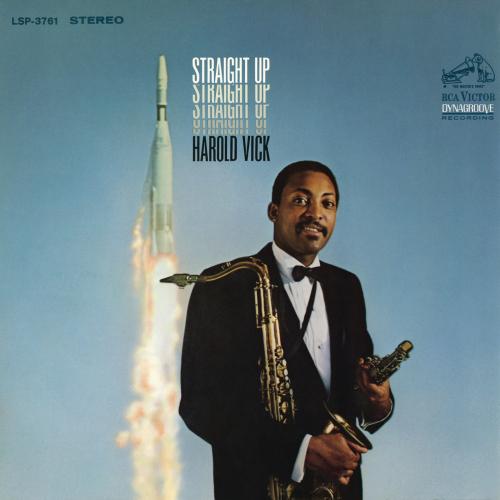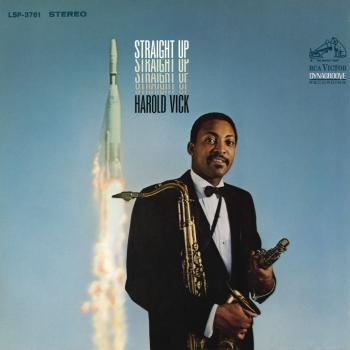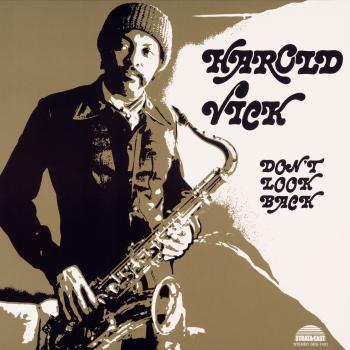
Straight Up (Remastered) Harold Vick
Album info
Album-Release:
1967
HRA-Release:
29.12.2017
Album including Album cover
I`m sorry!
Dear HIGHRESAUDIO Visitor,
due to territorial constraints and also different releases dates in each country you currently can`t purchase this album. We are updating our release dates twice a week. So, please feel free to check from time-to-time, if the album is available for your country.
We suggest, that you bookmark the album and use our Short List function.
Thank you for your understanding and patience.
Yours sincerely, HIGHRESAUDIO
- 1 If I Should Lose You 04:15
- 2 Like A Breath of Spring (Bossa) 02:41
- 3 Gone with the Wind 05:22
- 4 Staight Up 02:39
- 5 We'll Be Together Again 05:46
- 6 Lonely Girl (From Joseph E. Levine's "Harlow", a Paramount Pictures Release) 02:32
- 7 A Rose for Wray (Bossa) 05:42
- 8 Flamingo 04:56
- 9 Winter Blossom 05:03
Info for Straight Up (Remastered)
The superb Straight Up captures Harold Vick's shift away from the lithe tenor/organ sessions of his previous work toward the bold soul-jazz of his finest recordings. Supported by an unusual but effective lineup featuring guitarist Everett Barksdale, vibist Warren Chiasson, bassist Walter Booker, and drummer Hugh Walker, Vick alternates between tenor, soprano, and flute, greatly expanding the parameters of his sound while maintaining the simplicity that is his hallmark. Above all, he remains a remarkably expressive player, communicating more in one or two notes than most reedists say over the span of an entire song.
Harold Vick, tenor saxophone, soprano saxophone, flute
Virgil Jones, trumpet
Warren Chiasson, vibraphone
Albert Dailey, piano
Everett Barksdale, guitar (tracks 2, 4 & 6)
Walter Booker, bass
Hugh Walker, drums
Recorded October 3 & 4, 1966 at RCA Studio B in New York
Digitally remastered
Harold Vick
One of jazz’s great unsung saxophonists, Harold Vick can be placed in a category with the likes of Booker Ervin, David “Fathead” Newman, Wilton Felder, and James Clay — hard-toned, aggressive, funky tenorists who placed an emphasis on the blues even as they embodied state-of-the-art bop-derived modernism. Although he led relatively few recording dates, Vick was held in high regard by other leaders, especially such ’60s-era soul-jazz organists as Brother Jack McDuff, Jimmy McGriff, Shirley Scott, and Big John Patton. Vick also performed and recorded with many noted R&B and jazz vocalists, including Ray Charles, Aretha Franklin, Ashford & Simpson, Angela Bofill, Abbey Lincoln, and Lena Horne.
Vick was born in the same small North Carolina town — Rocky Mount — as pianist Thelonious Monk (his elder by 20 years). Vick started playing music at the age of 13 when his uncle Prince Robinson (a highly regarded tenor saxophonist who played with Louis Armstrong, Duke Ellington, McKinney’s Cotton Pickers, and others during the ’20s and ’30s) gave him a clarinet. At 16 Vick took up the tenor and soon after began playing in R&B bands. In the ’50s Vick moved to Washington, D.C., and studied psychology at Howard University. He continued to play, mostly with R&B bands.
His work with such organists as McDuff and McGriff began attracting attention. By the mid-’60s, Vick was leading his own groups, featuring such players as trumpeter Blue Mitchell and guitarist Grant Green. In 1963, he recorded his first album as a leader, Steppin’ Out!, for the Blue Note label. Between 1966 and 1974 he led dates for the RCA, Muse, and Strata East labels. In 1972 he recorded with Jack DeJohnette’s band Compost, one of the drummer’s first efforts at leading a band.
By the mid-’70s Vick had essentially stopped recording as a leader. His career as a sideman flourished, however. He continued working with organists Scott and McGriff, singers Franklin and Charles, Dizzy Gillepie’s big band, and with R&B acts both in the studio and on the road. Shortly before his death in 1987, Vick recorded a pair of Billie Holiday tributes with singer Abbey Lincoln for the enja label. In 1998 Sonny Rollins paid tribute to Vick by composing and recording a tune titled “Did You See Harold Vick?” (Chris Kelsey, AMG)
This album contains no booklet.











